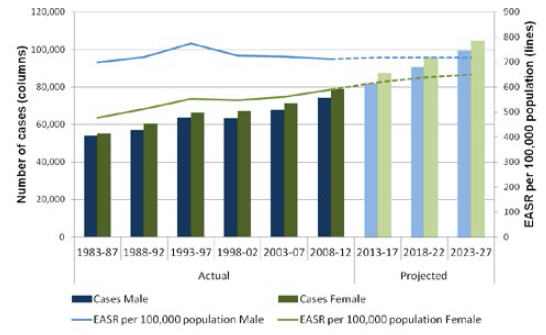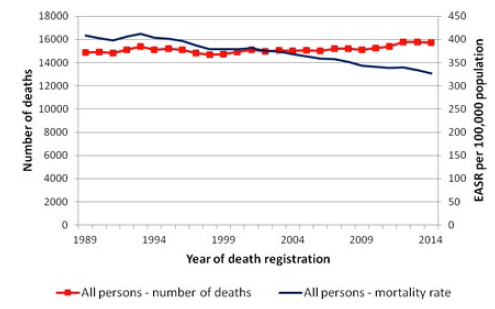Beating cancer: ambition and action
Cancer strategy containing more than 50 actions to improve cancer services across Scotland.
2. Scotland is Changing - Our Services Must Change With It
Scotland's population is changing and this will have an inevitable impact on the demand for health and social care, including cancer services. By 2039, the number of people in Scotland aged 65 or over is expected to increase by 53% to 1.5 million people and the number of households headed by people in this age group is set to increase by 54% to almost 1 million by 2037.[1] This is good news, but means we must plan to meet the increasing demands on our health and care services through the growth, nature, complexity and acuity of the disease being faced.
Although there is much to celebrate in the significant improvements that have been made in improving mortality and survival rates from cancer in recent years, the incidence of cancer continues to increase.
This presents new challenges that we, as a cancer community, must address in order to drive forward further service improvement and help reduce inequities in cancer care.
Over 40% of people in Scotland will be diagnosed with cancer during their lifetime. Around 1 in 13 men and 1 in 9 women will develop cancer before the age of 65.[2] The number of people being diagnosed with cancer continues to increase.
Around 32,000 people in Scotland were diagnosed with cancer in 2013, an increase of around 12% since 2003 and is expected to reach 40,000 diagnoses by 2023-27.[3] Approximately half of these diagnoses will be of the most common cancers: lung, breast, prostate and colorectal and the other half will be less common or rare cancers.
The rise in the number of diagnoses is due partly to the ageing population as a result of our successes in treating the most common killer diseases such as coronary heart disease and stroke as well as cancer. But it is also driven by changes in lifestyles.
Chart 1: All cancers (excluding non-melanoma skin cancer). Number of new cases and EASR per 100,000 population; 1983-87 to 2023-27[4]

Source: Scottish Cancer Registry, National Records of Scotland, NORDPRED[5]
There is considerable variation across different types of cancer and this will have an impact on the nature of demand for services. For instance, the incidence rate of malignant melanoma of the skin has increased by 30% over the last 10 years. In contrast, the incidence rate of cancer of the oesophagus has decreased by 8% over the same period. Lung cancer is predicted to continue to be the most common cancer in 2023-27.
Cancer mortality rates in Scotland have reduced by 11% over the last 10 years.[6] This reflects the progress made in the prevention, early detection and treatment of cancer. But the number of deaths due to cancer has remained constant which reflects an increase in older age groups within the population and the fact that cancer is a relatively common disease among the elderly.
Chart 2: Cancer[7] mortality in Scotland, 1989-2014. Number of deaths and age-standardised mortality rate[8]

Source: National Records of Scotland[9]
There is more to be done and in particular addressing the variation in mortality between men and women and certain tumour types. One of the keys to improving mortality rates is earlier diagnosis and treatment and the actions in this strategy build on our progress in improving screening rates and early detection.
Despite these improvements in mortality rates, in 2014, 15,746 people died from cancer in Scotland. Lung cancer accounts for the greatest number of deaths (26% of all cancers), followed by colorectal (10%), breast (6%) and prostate (6%).[10]
There is, however, good news. More people than ever before are surviving after cancer. People who were diagnosed with cancer between 1987 and 2011 have seen one-year survival rates increased in men from 48% to 66% and in women from 58% to 69%. Five-year survival rates have increased from 29% to 48% in men and from 40% to 54% in women. This increase is reported for most cancers with large advances in some tumour types, such as prostate, multiple myeloma, Non-Hodgkin's lymphoma, kidney cancer, leukaemia and female breast cancer.[11]
Health inequalities across Scotland mean that cancer incidence is more common in the most deprived areas of Scotland - incidence rates have typically been 30% to 50% higher in the most deprived compared to the least deprived areas. There are a number of reasons for this including lifestyle choices and variations in screening uptake which ultimately have an impact on cancer survival for some types of cancer. Health inequalities can also be found in cancer mortality rates. Of people in the 45 to 74 year age group, those living in most deprived areas are more than twice as likely to die of cancer than those in the least deprived areas.
Some of the most common types of cancer, where the gap between the most and least deprived areas is largest, are cancer of the trachea, bronchus and lung, mirroring the socially patterned smoking rates. Mortality rates show a similar picture. The gap between least and most deprived areas is projected to continue to widen and action therefore needs to be taken to reverse this.
Cancer and Healthy Life Expectancy
We also know that surviving after cancer is not always the same as living a full and healthy life. There can be long-term consequences of treatment that require ongoing care and support.
People who have been diagnosed with cancer have a greater risk of being diagnosed with cancer again in the future, and on some occasions people treated for a primary cancer will also develop secondary or metastatic cancer, which may be treatable although incurable. People may live for many years after cancer and should receive the treatment and support they need to live for as long and as well as possible at home, managing their cancer effectively as a long-term condition.
The experience and quality of life that people with cancer have through and beyond diagnosis and treatment is equally as important as clinical effectiveness and safety. It is therefore essential that we strive to deliver cancer care in ways to ensure that people receive the support they need to live as long and healthy a life as possible.
As the majority of people diagnosed with cancer are over the age of 65, many may already have multiple morbidities - it is estimated that 70% of people with cancer have at least one other long-term condition that needs managing and over a quarter have at least three other such conditions.[12]
Contact
Email: Helen Stevens
There is a problem
Thanks for your feedback